
Lilium is a genus of herbaceous flowering plants growing from bulbs, all with large prominent flowers. They are the true lilies. Lilies are a group of flowering plants which are important in culture and literature in much of the world. Most species are native to the temperate northern hemisphere, though their range extends into the northern subtropics. Many other plants have "lily" in their common names, but do not belong to the same genus and are therefore not true lilies.
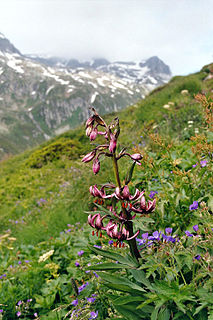
The lily family, Liliaceae, consists of about 15 genera and 610 species of flowering plants within the order Liliales. They are monocotyledonous, perennial, herbaceous, often bulbous geophytes. Plants in this family have evolved with a fair amount of morphological diversity despite genetic similarity. Common characteristics include large flowers with parts arranged in threes: with six colored or patterned petaloid tepals arranged in two whorls, six stamens and a superior ovary. The leaves are linear in shape, with their veins usually arranged parallel to the edges, single and arranged alternating on the stem, or in a rosette at the base. Most species are grown from bulbs, although some have rhizomes. First described in 1789, the lily family became a paraphyletic "catch-all" (wastebasket) group of petaloid monocots that did not fit into other families and included a great number of genera now included in other families and in some cases in other orders. Consequently, many sources and descriptions labelled "Liliaceae" deal with the broader sense of the family.
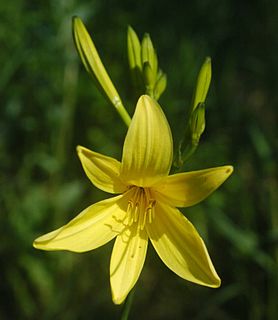
A daylily or day lily is a flowering plant in the genus Hemerocallis, a member of the family Asphodelaceae, subfamily Hemerocallidoideae. Despite the common name, it is not in fact a lily. Gardening enthusiasts and horticulturists have long bred daylily species for their attractive flowers. Thousands of cultivars have been registered by local and international Hemerocallis societies.

Lilium bulbiferum, common names orange lily, fire lily,Jimmy's Bane and tiger lily, is a herbaceous European lily with underground bulbs, belonging to the Liliaceae.

Lilium martagon, the martagon lily or Turk's cap lily, is a Eurasian species of lily. It has a widespread native region extending from Portugal east through Europe and Asia as far east as Mongolia.

Cardiocrinum is a genus of bulbous plants of the lily family first described in 1846. They are native to the Himalaya, China, the Russian Far East, and Japan. The bulbs are usually formed at the soil surface. The preferred habitat is woodland. The plants tend to be monocarpic, dying after flowering.

Lilium pardalinum, also known as the leopard lily or panther lily, is a flowering bulbous perennial plant in the lily family, native to Oregon, California, and Baja California. It usually grows in damp areas. Its range includes California chaparral and woodlands habitats and the Sierra Nevada.
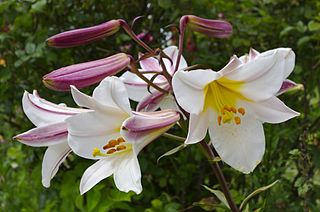
Lilium regale, called the regal lily, royal lily, king's lily, or, in New Zealand, the Christmas lily, is a species of flowering plant in the lily family Liliaceae, with trumpet-shaped flowers. It is native to the western part of Sichuan Province in southwestern China, and cultivated elsewhere as an ornamental. It was introduced to England in 1903 by Ernest Henry Wilson.

William Thomas Stearn was a British botanist. Born in Cambridge in 1911, he was largely self-educated, and developed an early interest in books and natural history. His initial work experience was at a Cambridge bookshop, but he also had a position as an assistant in the university botany department. At the age of 29 he married Eldwyth Ruth Alford, who later became his collaborator. He died in London in 2001.

Lilium davidii is an Asian species of plants in the lily family, native to mountainous areas of Assam, Manipur, Arunachal Pradesh, Tibet, Bhutan, Hubei, Shaanxi, Sichuan, Guizhou, and Yunnan.

Zephyranthes carinata, commonly known as the rosepink zephyr lily or pink rain lily, is a perennial flowering plant native to Mexico, Colombia and Central America. It is also widely cultivated as an ornamental and naturalized in the West Indies, Peru, Argentina, Brazil, the southeastern United States from Texas to Florida, Zimbabwe, South Africa, China, Korea, the Ryukyu Islands, Assam, Nepal, Bhutan, Sri Lanka, Solomon Islands, Queensland, Society Islands, Kiribati, and Caroline Islands.

Lilium nepalense, the lily of Nepal, is an Asian plant species in the lily family. It is native to the Himalayas and nearby regions: northern Thailand, northern Myanmar, Assam, Bhutan, Sikkim, Nepal, Uttarakhand, Tibet, and Yunnan. It can be found growing on wet forest borders at 1,200 to 3,000 m.

Lilium bolanderi is a rare North American species of plants in the lily family, known by the common name Bolander's lily. It is native to northwestern California and southwestern Oregon.

Lilium occidentale is a rare North American species of lily known by the common name western lily. Its species name 'Occidentale' means 'westernmost' and refers to its location along the West Coast. It is native to northwestern California and southwestern Oregon. It grows in coastal prairie habitat, swamps and stagnant bogs with Drosera species, bluffs and sandy cliffs, and seaside spruce forests. This rare wildflower is limited in distribution and directly endangered by a number of environmental factors. It is a federally listed endangered species and it is listed as endangered by the states of California and Oregon.

Lilium parryi, common name lemon lily, is a rare species of lily.
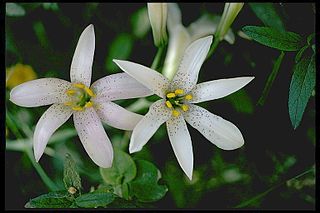
Lilium rubescens is an uncommon species of lily known by the common names redwood lily and chaparral lily. It is native to northwestern California and southwestern Oregon, where it is known from the Coast Ranges from Lane County to Santa Cruz Counties.

Notholirion is a small Asian genus of bulbous plants in the lily family, Liliaceae. It is closely related to Lilium, but each individual flowers only once, and then dies after producing offsets. The bulb is covered by a tunic. Leaves are basal, produced in autumn and winter.

Lilium wallichianum is an Asian species of bulbous plants in the lily family native to the Indian Subcontinent and to Myanmar. It is native to India, as well as Nepal, Bhutan, and Myanmar.
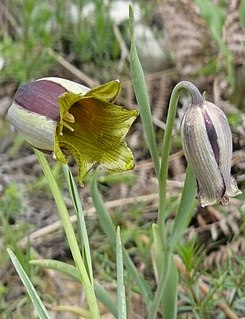
Fritillaria acmopetala, the pointed-petal fritillary, is a species of flowering plant in the lily family Liliaceae, native to rocky limestone mountain slopes in the Middle East. It was described by the Swiss botanist Pierre Edmond Boissier in 1846.

Lilium fargesii is a Chinese species of plants in the lily family native to Hubei, Shaanxi, Sichuan and Yunnan provinces of China.



















